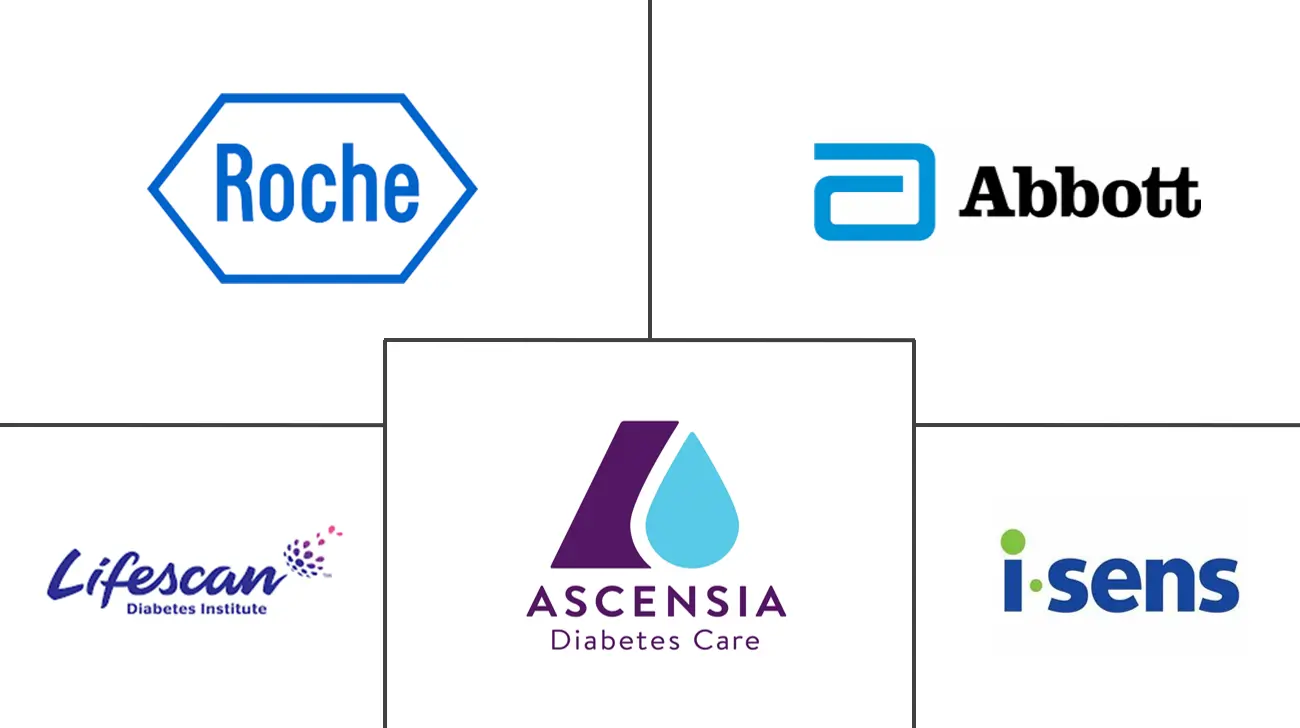Brazil Self-Monitoring Blood Glucose Devices Market Size and Share
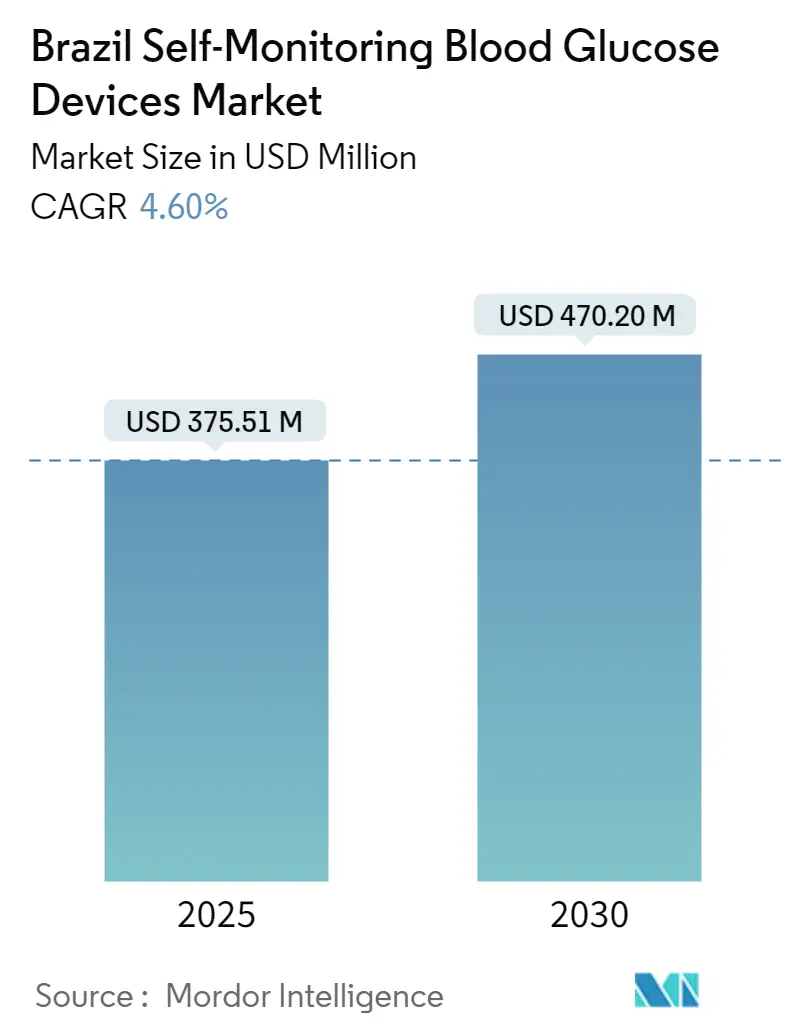
Brazil Self-Monitoring Blood Glucose Devices Market Analysis by Mordor Intelligence
The Brazil Self-Monitoring Blood Glucose Devices Market size is estimated at USD 375.51 million in 2025, and is expected to reach USD 470.20 million by 2030, at a CAGR of 4.6% during the forecast period (2025-2030).
Continued elevation in blood glucose levels in diabetes patients can contribute to progressive complications such as renal, nerve, and ocular damage. The measurement of blood glucose helps in determining the effectiveness of blood glucose metabolism and guides in achieving optimal glucose control within the body. Over time, the readings provide the patient and their health professionals with the information required to determine the best management strategy for diabetes. Appropriate and timely monitoring of blood glucose allows the successful management of out-of-range blood glucose levels, minimizing diabetic-related health complications.
In Brazil, the public health system (Sistema Nico de Sade; SUS) has been progressively increasing the assistance available for individuals with diabetes. The Ministry of Health established a list of medications and supplies provided by the Brazilian Health System (SUS) to patients suffering from diabetes. However, their supply is usually not sufficient or recommended for optimal patient management across cities. The high prevalence of diabetes is associated with a significant economic burden.
Technological advancements in blood glucose meters, including cellular-connected devices that automatically upload SMBG data to secure cloud-based databases, allow for improved sharing and monitoring of SMBG data. Real-time monitoring of SMBG data presents opportunities to provide timely support to patients who are responsive to abnormal SMBG recordings. Such advantages can provide patients with poorly controlled T2D with the additional support needed to improve critical outcomes, thereby enhancing the market's prospects in the years to come.
Brazil Self-Monitoring Blood Glucose Devices Market Trends and Insights
Rising Diabetes Prevalence in Brazil
The diabetes population in Brazil is expected to grow by about 2.9% over the forecast period.
According to the IDF Diabetes Atlas, 15.7 million adults, or 10.5%, were living with diabetes in Brazil. The cost of diabetes-related health expenditures in Brazil is the third-highest in the world. In addition, 18 million adults (around 11.9%) have impaired glucose tolerance, which places them at high risk of developing type-2 diabetes. 32% of people living with diabetes in Brazil are undiagnosed. Additional data on glycemic control in Brazil show that only 25% met the therapeutic goal of glycated hemoglobin (HbA1c) < 7% before the pandemic, as recommended by the Brazilian Diabetes Society (SBD).
When diabetes is undetected or inadequately treated, people with diabetes are at risk of serious and life-threatening complications, such as heart attack, stroke, kidney failure, blindness, and lower-limb amputation. These result in reduced quality of life and higher healthcare costs, leading to a greater need for access to care. Various pieces of evidence suggest that diabetes can be successfully managed, especially when detected early. Multifactorial intervention, including control of blood glucose, blood pressure, and lipids, can reduce the broad range of diabetes-related microvascular and macrovascular complications and premature mortality.
Therefore, owing to the increasing prevalence of diabetes, the studied market is anticipated to witness growth over the analysis period.
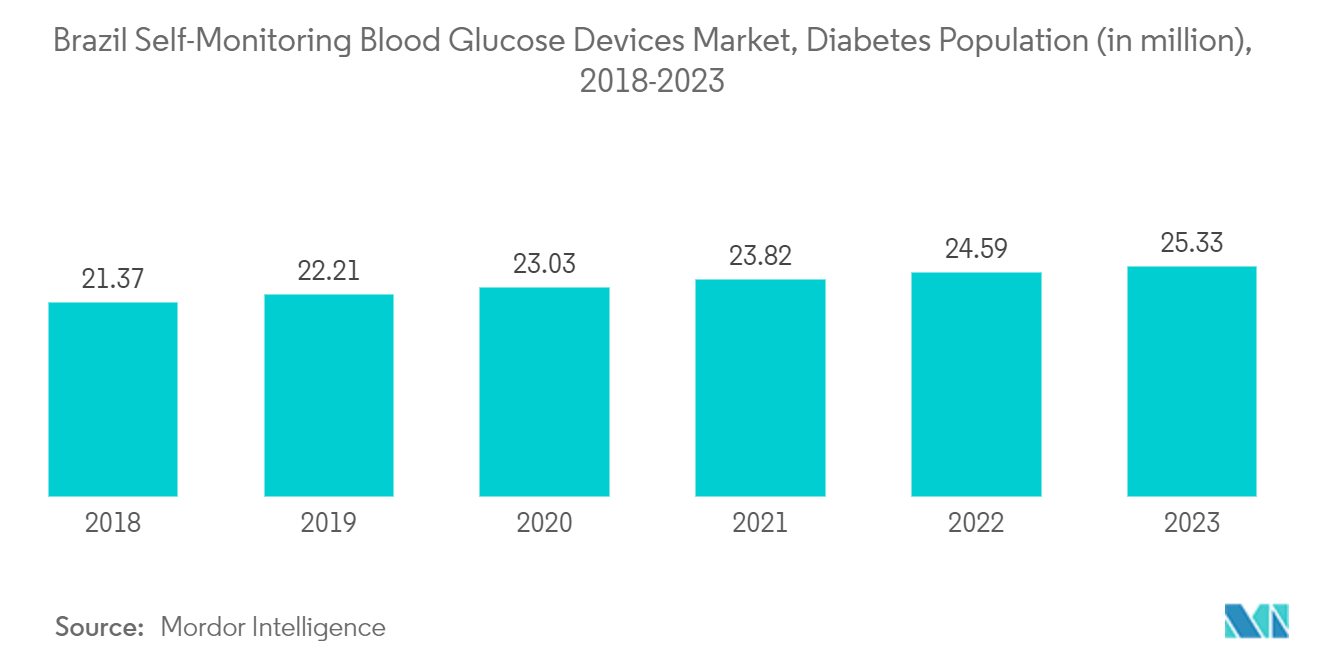
The Test Strips Segment holds the highest market share in the current year
The test strip segment held the highest market share of about 84% in the current year.
Blood glucose test strips are small, disposable strips and are a key component of blood glucose testing. When blood is placed on the test strip, it reacts with a chemical called glucose oxidase, producing gluconic acid from the glucose in the blood. At the other end of the test strip, the meter transfers a current to the strip. The test strip has electric terminals, which allow the meter to measure the current between the terminals. The current between the terminals changes depending on the level of gluconic acid that has been produced. The blood glucose meter then uses an algorithm to work out the blood glucose level based on the difference in current.
The growth in market share of test strips is expected to be higher than that of glucose meters because of the difference in use-case frequency. The glucometer is a one-time purchase; test strips, on the other hand, are a continuous investment as a test strip needs to be disposed of after one use, causing a recurrent cost impact. While an average glucose meter lasts anywhere between six months and three years, presenting a one-time cost during the same time frame,
Brazil has implemented a set of reforms over the past decade to improve the distribution of doctors, develop new forms of service organization, introduce new financing models, and implement a range of quality improvement initiatives and policy frameworks to overcome risk factors such as obesity and emerging threats. The Federal Government of Brazil partnered with numerous private companies to utilize their supply chain (manufacturing, distribution, and retailers), primarily to ensure low prices.
Thus, the above-mentioned factors are expected to drive the segment's growth over the forecast period.
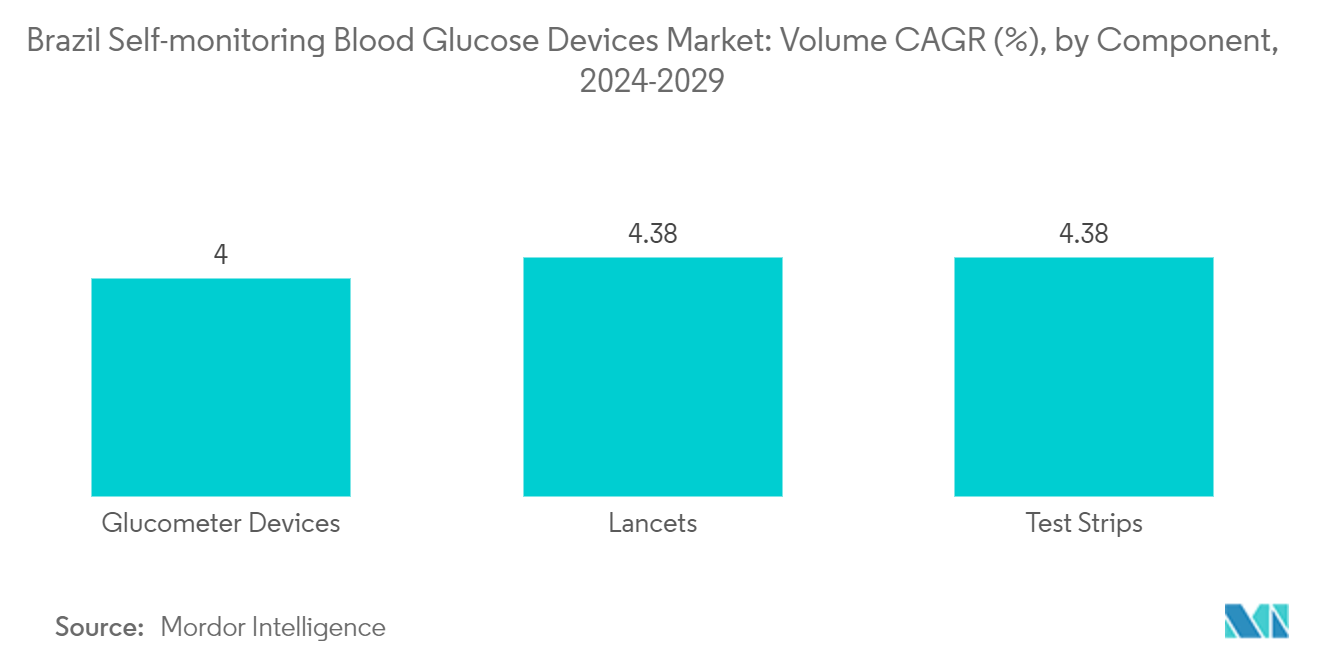
Competitive Landscape
The Brazil self-monitoring blood glucose device market is fragmented, with few significant and other generic players. Manufacturers like Abbott, LifeScan, Roche, Ascensia, etc. occupy a major share.
Brazil Self-Monitoring Blood Glucose Devices Industry Leaders
-
Roche Diabetes Care
-
Abbott Diabetes Care
-
LifeScan
-
Ascensia Diabetes Care
-
i-Sens
- *Disclaimer: Major Players sorted in no particular order
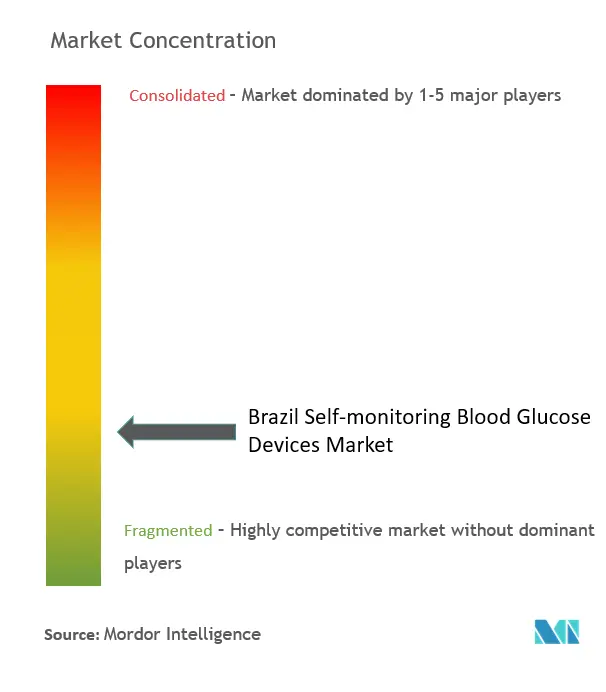
Recent Industry Developments
- January 2023: LifeScan announced that the peer-reviewed Journal of Diabetes Science and Technology published Improved Glycemic Control Using a Bluetooth Connected Blood Glucose Meter and a Mobile Diabetes App: Real-World Evidence From Over 144,000 People With Diabetes, detailing results from a retrospective analysis of real-world data from over 144,000 people with diabetes - one of the largest combined blood glucose meter and mobile diabetes app datasets ever published.
- June 2022: LifeScan announced that the peer-reviewed journal Diabetes Technology and Therapeutics published Real World Evidence of Improved Glycemic Control in People with Diabetes using a Bluetooth-connected Blood Glucose Meter with Mobile Diabetes Management Application using the OneTouch Reveal mobile app with the OneTouch Verio Reflect meter- synced via Bluetooth wireless technology could support improved glycemic control for people with diabetes.
Brazil Self-Monitoring Blood Glucose Devices Market Report Scope
Self-monitoring of blood glucose is an approach used by diabetic patients to measure their blood sugar level themselves using a glucometer, test strips, and lancets. Based on the readings, patients can adjust or check the effect of their treatment. The Brazil self-monitoring blood glucose device market is segmented into components. The report offers the value (in USD) and volume (in units) for the above segments.
| Glucometer Devices |
| Test Strips |
| Lancets |
| Component | Glucometer Devices |
| Test Strips | |
| Lancets |
Key Questions Answered in the Report
How big is the Brazil Self-Monitoring Blood Glucose Devices Market?
The Brazil Self-Monitoring Blood Glucose Devices Market size is expected to reach USD 375.51 million in 2025 and grow at a CAGR of 4.60% to reach USD 470.20 million by 2030.
What is the current Brazil Self-Monitoring Blood Glucose Devices Market size?
In 2025, the Brazil Self-Monitoring Blood Glucose Devices Market size is expected to reach USD 375.51 million.
Who are the key players in Brazil Self-Monitoring Blood Glucose Devices Market?
Roche Diabetes Care, Abbott Diabetes Care, LifeScan, Ascensia Diabetes Care and i-Sens are the major companies operating in the Brazil Self-Monitoring Blood Glucose Devices Market.
What years does this Brazil Self-Monitoring Blood Glucose Devices Market cover, and what was the market size in 2024?
In 2024, the Brazil Self-Monitoring Blood Glucose Devices Market size was estimated at USD 358.24 million. The report covers the Brazil Self-Monitoring Blood Glucose Devices Market historical market size for years: 2019, 2020, 2021, 2022, 2023 and 2024. The report also forecasts the Brazil Self-Monitoring Blood Glucose Devices Market size for years: 2025, 2026, 2027, 2028, 2029 and 2030.
Page last updated on:
Brazil Self-Monitoring Blood Glucose Devices Market Report
Statistics for the 2025 Brazil Self-Monitoring Blood Glucose Devices market share, size and revenue growth rate, created by Mordor Intelligence™ Industry Reports. Brazil Self-Monitoring Blood Glucose Devices analysis includes a market forecast outlook for 2025 to 2030 and historical overview. Get a sample of this industry analysis as a free report PDF download.
